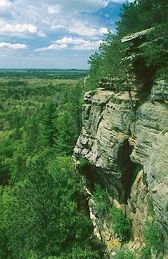Roche-A-Cri Mound
No. 183

Photo by Thomas A. Meyer/DNR
Probably the most conspicuous and beautiful rock in Wisconsin is bold, irregular Roche-a-Cri, a late Cambrian sandstone outlier mesa of the retreating Magnesian Escarpment. Named by early French explorers, Roche-a-Cri or "crevice in the rock" refers to the large cleft in the rock structure that is visible from a distance. Three complete erosion cycles are evident within the rock strata. The distinctly shaped mound was once a rocky island in the former Glacial Lake Wisconsin and is long and narrow with a flat-topped ridge bordered by craggy, precipitous cliffs. The summit stands about 300 feet above the Central Sands plain and offers excellent views of several other late Cambrian sandstone crags and towers including Pilot Knob, Mosquito Mound, Rattlesnake Mound and Dorro Couche. These white rocky battlements punctuate the even, green plane that surrounds Roche-a-Cri. Vegetation at the top of the mound consists of scattered red, black, and white oak with red, white, and jack pine. Plants characteristic of bracken grassland, sand barrens, cliff and dry forest and prairie communities grow here too. Turkey vultures use the high mound as a roost site. Below, lies a long and steep talus slope, which harbors a small, narrow rock shelter containing rock art. "Crow feet" petroglyphs are present at the base of the mound and protected by a fence as they have been partially destroyed by vandals. Roche-a-Cri is owned by the DNR and was designated a State Natural Area in 1983.
Very few State Natural Areas have public facilities, but nearly all are open for a variety of recreational activities as indicated below. Generally, there are no picnic areas, restrooms, or other developments. Parking lots or designated parking areas are noted on individual SNA pages and maps. If a developed trail is present, it will normally be noted on the SNA map and/or under the Maps tab. A compass and topographic map or a GPS unit are useful tools for exploring larger, isolated SNAs.
The good majority of SNAs are isolated and have few or no facilities. Some SNAs have vehicle access lanes or parking lots, but their accessibility may vary depending on weather conditions. Parking lots and lanes are not plowed during winter. Hiking trails may be nonexistent or consist of undeveloped footpaths. A GPS unit or compass and a detailed topographic map are useful tools for exploring larger SNAs.
Entrance fees: Except for Parfrey's Glen, Pewits Nest, the Dells of the Wisconsin River, SNAs within State Parks and some within State Forests, all other DNR-owned SNAs do not have any admission fees. For more information, see Wis. Admin. Code NR 45. For non-DNR-owned SNAs, we are unaware of any vehicle or admission fees. However, please contact the landowner for more information.
Allowable activities: DNR-owned land
The activities listed below are generally allowed on all DNR-owned SNA lands. Exceptions to this list of public uses, such as SNAs closed to hunting, are noted above and posted with signs on the property site.
- Hiking
- Fishing
- Cross country skiing
- Hunting
- Trapping
- Scientific research (permit required)
- Outdoor education
- Wild edibles (What is this?)
- Pets (Rules)
- Wildlife viewing
Prohibited activities: all SNAs
Although a handful of sites allow activities like primitive camping (e.g. Lower Chippewa River on sand bars) or horseback riding (e.g. S. Kettle Moraine), the activities listed below are generally prohibited on DNR-owned SNAs.
- Camping and campfires
- Collecting of animals (other than legally harvested species), non-edible fungi, rocks, minerals, fossils, archaeological artifacts, soil, downed wood, or any other natural material, alive or dead.
- Collecting for scientific research requires a permit issued by the DNR
- Collecting of plants including seeds, roots or other non-edible parts of herbaceous plants such as wildflowers or grasses
- Drones: Flying-related activities, including the use of drones, hang-gliders and model airplanes, are prohibited. Permission may be issued by the SNA Program for the use of drones for educational or research purposes
- Geocaching
- Horseback riding
- Rock climbing
- Vehicles, including bicycles, ATVs, aircraft and snowmobiles except on trails and roadways designated for their use.
For rules governing state-owned SNAs and other state lands, please consult Chapter NR 45 Wis. Admin. Code.
Location
Within Roche-a- Cri State Park, Adams County. T18N-R6E, Section 30. 22 acres.
Driving directions
From the intersection of County Highway J and State Highway 13 in Friendship, go north on 13 2 miles to the Roche-a-Cri State Park entrance. Park maps are available at the contact station. Follow the park road to the northwest base of the mound. A 303-step stairway leads to the summit. For the eastern portion, go north from the park on Highway 13 0.7 miles, then east on Cypress Avenue 0.4 miles to a parking area south of the road. NOTE: During winter, the main park entrance is closed and visitors should park in the lot on the north side of Czech Avenue, west of State Highway 13.
The DNR's state natural areas program is comprised of lands owned by the state, private conservation organizations, municipalities, other governmental agencies, educational institutions and private individuals. While the majority of SNAs are open to the public, access may vary according to individual ownership policies. Public use restrictions may apply due to public safety, or to protect endangered or threatened species or unique natural features. Lands may be temporarily closed due to specific management activities.
Users are encouraged to contact the landowner for more specific details. The data shown on these maps have been obtained from various sources, and are of varying age, reliability, and resolution. The data may contain errors or omissions and should not be interpreted as a legal representation of legal ownership boundaries. To create your custom map where you can zoom to a specific location, please use the DNR's Mapping Application.
Roche-A-Cri Mound is owned by: Wisconsin DNR
